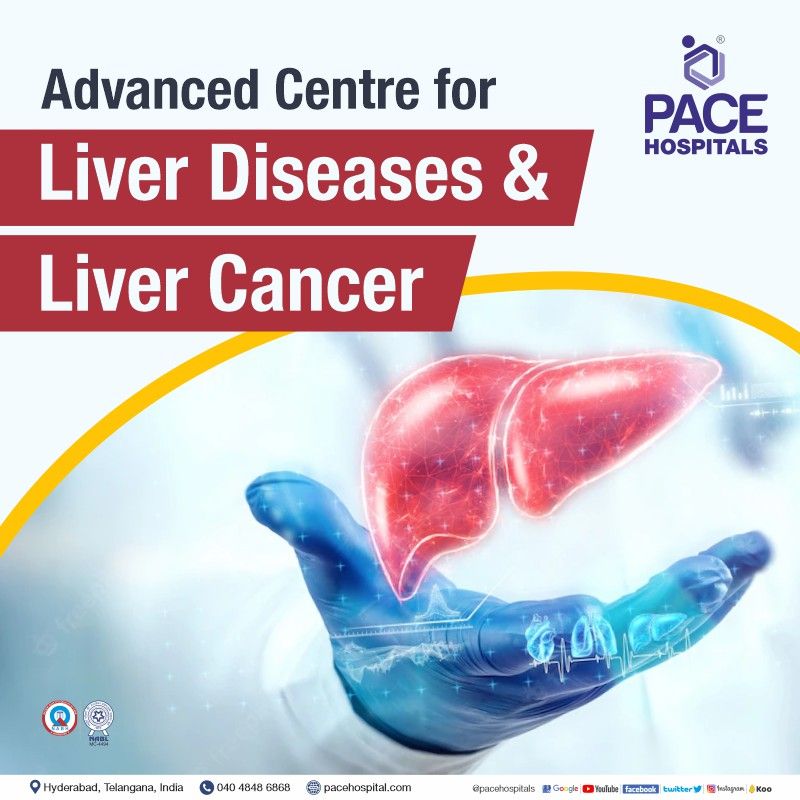Best Hepatology Hospital in Hyderabad, India| All types of Liver Diseases
Nationally and Internationally Award-winning team of liver specialists, hepatology doctors, liver transplant surgeons; successfully treating complex diseases and conditions of liver and cancers:
- Fatty liver disease and Liver Cirrhosis
- Hepatitis A, Hepatitis B, and Hepatitis C
- Alcoholic Liver Disease - Alcoholic Hepatitis, Alcoholic fatty liver disease
- Wilson's disease and Hemochromatosis
- Non-alcoholic fatty liver disease (NAFLD)
- Ascites, Budd chiari syndrome
- Liver Cancer
- Jaundice and
many more
Request an appointment
We are available at Hitech City and Madinaguda
Hepatology (Liver Specialist) appointment
Thank you for contacting us.
We will get back to you as soon as possible
Oops, there was an error sending your message.
Please try again later
The Department of Hepatology and Liver Surgery

Deals with the study, prevention, diagnosis and treatment of disorders that affect the liver.
PACE Hospitals is one of the best liver hospital in Hyderabad, has integrated operating suites and ultra-modern intensive care units that ensure superlative degree of patient care in a supportive environment. The Department of Hepatology and liver surgery has well-trained and quailed doctors. The professional team of hepatology doctors and surgeons is highly skilled and performs the interventional procedures and surgeries with a lot of dedication which result in exceptional outcomes.
Our expertise in diagnose and treatment of esophagus, stomach, liver, pancreas, biliary tract, small and large intestines' disease and cancers, which signifies PACE Hospitals as one of the best liver specialist hospital in Hyderabad. We also offer treatment via therapeutic endoscopy, which helps in diagnosis and simultaneously treats complex, hard to find problems in the gastrointestinal tract. Treatments like Whipple surgery, Lap cholecystectomy, Liver biopsy and bariatric surgery are carried out with the highest level of precision by our team of Hepatologist / Liver specialist doctors.
Our Team of Top Hepatology Doctors (Liver Specialist) in Hyderabad
-
Dr. Govind Verma
Book appointment23+ years of exp.
Interventional Gastroenterologist, Transplant Hepatologist, Pancreatologist & Endosonologist
-
Dr. M Sudhir
Book appointment35+ years of exp.
Senior Gastroenterologist & Liver Specialist (Hepatologist)
-
Dr. R Venkatesh Reddy
Book appointmentConsultant Gastroenterologist and Hepatologist
Our Team of Best HPB & Liver Surgeon Doctors in Hyderabad
-
Dr. Ch Madhusudhan
Book appointment27+ years of exp.
Senior Consultant Surgical Gastroenterologist and Liver Transplant Surgeon
-
Dr. Phani Krishna Ravula
Book appointment20+ years of exp.
Consultant Surgical Gastroenterologist, HPB and Liver Transplant Surgeon
-
Dr. Suresh Kumar S
Book appointment10+ years of exp.
Consultant Surgical Gastroenterologist, Laparoscopic and Liver Transplant Surgeon
What we treat?
We offer a treatment for wide range of liver and pancreas disorders.
-
Liver Infection
A liver infection is an inflammatory condition of the liver caused by heavy alcohol use, toxins, certain medications, autoimmune disorders, and viral infection that impairs liver function and is generally characterized by symptoms like itchy skin, pain & swelling in the abdomen, dark urine & pale stool colour, fatigue, nausea and shivering attacks. Liver infection due to viral infection (hepatitis) is caused by the most common types of viral hepatitis A, B, and C.
Hepatitis A is usually spread through contaminated food or water and is generally self-limiting, while Hepatitis B and C are usually spread through contact with infected blood, such as through shared needles or unprotected sex. These types of hepatitis can lead to chronic infection and cause serious liver damage over time.
-
Alcoholic Liver Disease
Alcoholic fatty liver disease (AFLD) is a condition in which the liver becomes damaged as a result of excessive alcohol consumption. When a person drinks alcohol, their liver breaks down the alcohol into toxic by-products that can damage liver cells. Over time, this damage can lead to the accumulation of fat in the liver, which can cause inflammation and scarring of the liver tissue, known as fibrosis.
Alcoholic fatty liver disease is the earliest stage of alcohol-related liver disease. It is reversible if the person stops drinking. But if drinking continues, it can progress to a more serious condition called alcoholic hepatitis, which is characterized by inflammation and damage to liver cells, and can ultimately lead to liver cirrhosis and liver failure.
-
Hepatitis
Hepatitis is characterised by inflammation of the liver, which is caused by several factors, including but not limited to excessive alcohol consumption, autoimmunity, and drug or toxin-induced. Depending on the underlying cause, hepatitis can range in severity from mild and self-limiting to life-threatening and transplant-required. A viral infection called "viral hepatitis" is the most common cause of hepatitis (A TO E).
In terms of how long the liver has been under attack, hepatitis can be further broken down into acute and chronic forms. Acute hepatitis defines as the inflammation of the liver that lasts for less than six months, whereas chronic hepatitis is the term used when it lasts for longer than six months. However, depending on the underlying cause, acute hepatitis can result in fatal liver failure and even death. Liver fibrosis, cirrhosis, hepatocellular carcinoma, and portal hypertensive characteristics are all forms of liver damage that can be caused by chronic hepatitis, which is associated with a higher risk of death.
-
Alcoholic Fatty Liver Disease
Alcoholic fatty liver disease (AFLD) is a condition in which the liver becomes damaged as a result of excessive alcohol consumption. When a person drinks alcohol, their liver breaks down the alcohol into toxic by-products that can damage liver cells. Over time, this damage can lead to the accumulation of fat in the liver, which can cause inflammation and scarring of the liver tissue, known as fibrosis.
Alcoholic fatty liver disease is the earliest stage of alcohol-related liver disease. It is reversible if the person stops drinking. But if drinking continues, it can progress to a more serious condition called alcoholic hepatitis, which is characterized by inflammation and damage to liver cells, and can ultimately lead to liver cirrhosis and liver failure.
-
Cirrhosis
Cirrhosis is the fatal stage of liver disease, characterised by scarring, which results from persistent damage and disrupts the liver's typical lobular architecture. Liver damage can be caused by many factors, including viruses (viral hepatitis), genetic predispositions, and drug-induced and autoimmune reactions. The liver generates scar tissue in response to injury, but it can usually continue functioning normally at first. Most liver tissue fibrosis occurs after prolonged damage, resulting in diminished function and the eventual onset of cirrhosis. Micronodular, macronodular, and mixed cirrhosis are the three main morphological categories of liver cirrhosis.
There are generally no symptoms of cirrhosis until the damage to the liver has progressed significantly. In some patients, it might show some potential symptoms that include weakness, low appetite, vomiting feeling, yellow discolouration of eyes and skin, lower limb oedema (swelling) such as feet and legs, ascites (fluid collection in the abdominal cavity), weight reduction, skin itchiness, red palms of the hands. In men, there might be enlargement of the breast, lack of focus, and slurred speech, whereas, in women, there is the absence of periods (unrelated to menopause).
-
Jaundice
Jaundice, also called hyperbilirubinemia, is characterised by yellow skin discoloration due to an excess accumulation of bilirubin (yellow to orange-colour bile pigment) in the blood. Bilirubin deposition occurs only when there is an excess of bilirubin, which indicates either excessive production or decreased excretion. The normal range for bilirubin in the blood is 1 mg/dL.
However, when blood bilirubin levels are above 3 mg/dL, the clinical appearance of jaundice with peripheral yellowing of the eye sclera occurs, also known as scleral icterus. As serum bilirubin levels rise, the skin's pigmentation changes, moving from lemon yellow to apple green (the green colour is caused by biliverdin). An increase in either unconjugated (indirect) or conjugated (direct) forms of bilirubin leads to jaundice disease.
-
Chronic Liver Disease
Chronic liver disease is a condition that gradually damages the liver over time. Some common causes of chronic liver disease include viral hepatitis, alcohol abuse, and nonalcoholic fatty liver disease (NAFLD). Symptoms may include fatigue, weakness, weight loss, and abdominal discomfort. Treatment options vary depending on the specific type of liver disease and may include medications, lifestyle changes, and, in some cases, surgery.
-
Wilson's Disease
Wilson disease is a rare autosomal recessive disorder that occurs due to excess copper accumulation throughout the body, most notably in the liver, brain, and cornea. Mutations in the ATP7B gene on chromosome 13 lead to Wilson's disease. This gene regulates a protein transporter that helps to excrete excess copper from the human body through the bile. The protein transporter is found in the liver and brain's trans-Golgi network.
The liver is responsible for excreting 95% of the body's copper. The liver becomes overwhelmed as the excess copper initially accumulates in the liver and later spills out, eventually making its way through the blood and into other organs. Oxidation of essential proteins and lipids is triggered by the free radicals produced due to surplus copper. These free radicals can cause damage to the cellular macromolecules, further leading to hepatocellular injury. Fatigue, weakness, ascites, leg swelling, skin yellowing, and itching are all symptoms of liver disease.
-
Hepatic Encephalopathy
Patients with severe liver impairment often have a reversible hepatic encephalopathy (HE) syndrome. A range of neuropsychiatric disorders caused by neurotoxic chemicals accumulating in the blood and in the brain is the characteristic of this disease. Kidney failure, bleeding from the gastrointestinal tract, difficulty in passing stools, non-compliance to medications, infections, high protein intake from the diet, electrolyte imbalance, alcohol consumption, certain sedatives, analgesics, or diuretics and dehydration can all lead to hepatic encephalopathy.
The patient might feel any or all common symptoms such as disorientation, depression, low awareness, and changes in personality. In the first stages, patients frequently sleep throughout the day and remain awake all night. Patients typically show tiredness, confusion, and changes in personality throughout the middle stages. Later stages of hepatic encephalopathy can cause coma and even death.
-
Gilbert Syndrome
Gilbert syndrome is an autosomal recessive disorder characterised by disrupted bilirubin metabolism in the liver. Unconjugated hyperbilirubinemia and recurrent jaundice result from impaired glucuronidation of bilirubin (a vital step for bilirubin excretion). Gilbert syndrome doesn’t require any treatment; hence, differentiating Gilbert syndrome from other illnesses of unconjugated hyperbilirubinemia is necessary.
A wide range of factors can lead to unconjugated hyperbilirubinemia and jaundice in people with Gilbert syndrome. Common triggers include haemolysis, increased body temperature than normal, fasting, menstruation, and physical exercise. The bilirubin levels for unconjugated hyperbilirubinemia with Gilbert syndrome are usually below 4 mg/dL but can fluctuate depending on exacerbating factors.
-
Autoimmune Hepatitis
Autoimmune hepatitis is a chronic, continuous exacerbating liver inflammation caused by an autoimmune response. Chronic inflammation of hepatocytes and liver fibrosis is hypothesised to result from the interaction of genetic predisposition, an environmental trigger, and failure of the native immune system, thus developing autoimmune hepatitis. Two distinct forms of autoimmune hepatitis have been identified. The presence of anti-smooth muscle antibodies (ASMA), with or without anti-nuclear antibodies, is the diagnostic parameter of type 1.
Anti-liver/anti-kidney microsome (anti-LMK) type 1 antibodies and anti-liver cytosol (anti-LC) type 1 antibodies diagnose type 2 autoimmune hepatitis. The symptoms include fatigue, abdominal pain, joint pain, abdomen swelling due to an increase in the size of the liver and spleen, yellow discolouration of skin and eyes, and spidery blood vessels in the skin.
-
Hepatorenal Syndrome
Hepatorenal syndrome (HRS) is a condition that causes progressive kidney failure in people who have cirrhosis or advanced chronic liver disease. It is a serious complication that might lead to death. Less urine is produced by the body due to renal (kidney) inefficiency to excrete waste products, leads to nitrogen build up in the bloodstream, known as azotemia. The disorder occurs in up to 1 in 10 people who are in the hospital with liver failure. In a few patients, Hepatorenal Syndrome (HRS) can arise independently, while in others, it is linked to bacterial infections and acute alcoholic hepatitis. The symptom might include urine discolouration (dark), vomiting, low urine output, weight changes, and yellow discolouration of the skin.
-
Non-alcoholic Fatty Liver Disease
The term "non-alcoholic fatty liver disease" (NAFLD) is used to describe a spectrum of conditions characterised by the existence of hepatic steatosis on imaging or histology (macro-vesicular steatosis) and absence of secondary causes of hepatic steatosis, such as heavy alcohol consumption, long-term use of medications that can cause hepatic steatosis or inherited disorders.
Non-alcoholic fatty liver disease has been associated with an increase in body weight (obesity), an increase in blood sugar levels, dyslipidaemias, resistance to insulin, and metabolic syndrome. No symptoms are typically associated with NAFLD, but in some cases, it might show fatigue and pain in the right abdomen(right). Simple steatosis, steatohepatitis, fibrosis, cirrhosis, and hepatocellular cancer are all possible stages of progression for NAFLD.
-
Alcoholic Hepatitis
Alcoholic hepatitis is a condition that occurs when you drink too much alcohol or binge drinking on a regular basis. It can cause inflammation of the liver, which can lead to permanent damage. If you drink too much alcohol for a long time, this inflammation can lead to scarring in the liver (cirrhosis) and eventually even liver cancer. It's more common in men than women and is most likely to occur in people who have other medical conditions such as obesity, diabetes or high blood pressure.
-
Liver Cancer
It is also known as hepatic cancer, which begins in the liver's cells, and the liver can develop several types of cancer. Hepatocellular carcinoma is the most frequent type of liver cancer, and it develops in the major type of liver cell (hepatocyte). Several risk factors contribute to the onset of chronic liver disease, leading to hepatocellular carcinoma.
Hepatitis B or hepatitis C (HBV or HCV) associated with chronic infection increases the risk of developing hepatocellular cancer. Chronic hepatitis infections with additional risk factors, such as hepatitis D (HDV) coinfection, frequent alcohol consumption, and cigarette use, may be associated with an increased risk of liver cancer.
-
Dubin-Johnson Syndrome
This is a rare type of hereditary hyperbilirubinemia, characterised by a low-grade increase in conjugated bilirubin with no other signs of hepatic damage. It is caused by a mutation of the ABCC2 gene that makes hepatocytes (liver cells) unable to excrete bilirubin from the liver. The mutation of the ATP-binding cassette subfamily C member (ABCC2) gene is the leading cause of Dubin-Johnson syndrome. There are no severe implications to this disorder, and no treatment is necessary.
The ABCC2 gene acts as an instructor for providing multidrug resistance protein 2 (MRP2), which transports conjugated bilirubin out of the liver cells into the bile duct as a part of bilirubin excretion. Due to the ABCC2 gene, there will be a lack of canalicular MRP2 expression, which impedes the entry of conjugated bilirubin into the bile duct system. Conjugated bilirubin builds up in hepatocytes, and its levels in the blood rise.
-
Glycogen Storage Disease
It is a rare condition where there will be an abnormality in the way the body consumes and stores glycogen (sugar or glucose). This condition affects a small percentage of the population. Glycogen is the body's primary energy source, stored in the liver. Enzymes are proteins that convert glycogen stored in the liver into glucose when the bodies require more energy. People with GSD lack a key enzyme necessary for proper glycogen breakdown, resulting in glycogen accumulation in the liver. Due to this, the liver, the muscles, and other organs may all be negatively affected.
Transmission of GSD occurs throughout generations (is hereditary). Based on the enzyme missed, they are several types, where type 1 (von Gierke disease), 3(Cori disease, or Forbes disease), and 4 (Andersen disease) mostly occur. The general symptoms include slow growth, intolerance to heat, abdominal swelling, liver enlargement, low blood sugar levels, muscle pain and cramping on exercise.
-
Alcoholic Liver Cirrhosis
Alcoholic liver cirrhosis is a result of the continuous damage to the liver due to excessive drinking. The damage causes the liver cells to die and be replaced by scar tissue, which makes the liver less able to function normally. As the disease progresses, the liver becomes harder and less able to filter toxins, produce bile, and regulate the metabolism of nutrients.
-
Acute Liver Failure
Acute liver failure is when the liver suddenly stops working properly. It is a rare but severe condition that can occur due to various causes, such as viral hepatitis, drug-induced liver injury, or toxins.
Symptoms of acute liver failure (ALD) can include nausea, vomiting, abdominal pain, confusion, and jaundice (yellowing of the skin and eyes). Treatment for acute liver failure typically involves hospitalization, supportive care, and, sometimes, a liver transplant.
-
Hemochromatosis
Hemochromatosis occurs when the body has abnormally high levels of iron due to excessive absorption and storage in organs, especially in the liver, heart, pancreas, endocrine glands, and joints. This excess iron build-up can harm organs and tissues, leading to major health consequences. Most cases of hemochromatosis are due to a mutation in a gene that controls the absorption of iron from the diet. There are a few types of hemochromatosis, among which hereditary hemochromatosis is the most common.
In hereditary hemochromatosis, the altered or modified (mutation) gene is then passed on to the next generation, which alters normal iron absorption. A patient with hereditary hemochromatosis may show no symptoms or exhibit a wide range of general and organ-specific signs and symptoms. Arthralgia, severe fatigue, erectile dysfunction, weight loss, and abdominal pain are the most often reportedsymptoms.
-
Liver Cyst
A liver cyst is a fluid-filled sac that develops within the liver. They are generally benign, meaning they are not cancerous, and usually cause no symptoms. They are usually discovered incidentally during imaging tests performed for other reasons.
There are two types of liver cysts: simple cysts and complex cysts. It is important to note that a liver cyst does not necessarily mean a person has liver disease. However, if a cyst is complex or causing symptoms, it is important to consult a specialist to further evaluate and monitor it.
-
Liver Abscess
A hepatic abscess is a pus-filled mass in the liver that can result from liver damage or an infection that has spread through the portal vein and into the abdominal cavity. Some of these abscesses are caused by parasites and fungi, but the majority are classified as pyogenic or amoebic. Entamoeba histolytica causes the vast majority of amoebic illnesses. Pyogenic abscesses are typically polymicrobial. However, E.coli, Klebsiella, Streptococcus, Staphylococcus, and anaerobes are frequently found within them.
Liver abscesses are uncommon, but there is a high mortality rate among untreated patients. Therefore, early detection and management are crucial. With advances in detection and treatment, the prevalence of liver abscesses caused by appendicitis has dropped to fewer than 10%. The most common causes of pyogenic liver abscesses nowadays are diseases of the biliary tract (such as biliary stones, strictures, malignancy, and congenital abnormalities). Symptoms might include pain in the abdomen (right upper), chills with fever, low appetite, weakness, yellow skin, nausea, dark urine and clay-coloured stools.
-
Alcoholic Liver Damage
Damage to the liver from alcohol intake is a chronic condition. Fatty liver, hepatitis, and cirrhosis are just a few of the liver issues that might develop the condition. Alcohol-related liver disease can cause various symptoms, including lethargy, weakness, weight loss, and jaundice. Limiting or avoiding alcohol usage is the best way to protect against alcoholic liver damage.
-
Non-alcoholic Steatohepatitis
NASH (Non-alcoholic steatohepatitis) is a malignant condition and in this fat is accumulated in the liver can cause scarring of liver, liver fibrosis and liver damage further it can cause cirrhosis of liver (also called as end-stage liver disease), further cirrhosis of the liver may lead to liver cancer.
-
Reye Syndrome
Reye syndrome is a rare and severe form of acute noninflammatory encephalopathy that can affect children. A child with Reye syndrome may exhibit symptoms like vomiting and confusion if the condition progress, it might lead to coma and death. If aspirin was used while recovering from a viral illness, this syndrome might occur in the days following full recovery.
Viruses such as influenza A and B and varicella are the most common causes of Reye syndrome. In addition, Reye syndrome can be caused or exacerbated by drug reactions, as well as predisposing factors such as inborn errors of metabolism (a disorder where the body cannot adequately convert food into energy). The diagnosis relies on the patient's symptoms and the results of laboratory tests.
-
Galactosemia
The word “Galactosemia” means to be the presence of “galactose in blood”. It is a rare inherited carbohydrate metabolism condition where the body cannot convert galactose to glucose. Galactose is a type of sugar in human breast milk, like other milk containing the sugar galactose. Galactose also produces in the human body and is termed endogenous galactose. Galactosemia is caused by alterations (mutations) in the galactose-1-phosphate uridylyltransferase (GALT) gene, leading to deficits in the GALT enzyme.
The lack of the galactose-1-phosphate uridylyltransferase (GALT) enzyme (which converts galactose to glucose) leads to an abnormal build-up of galactose in various organs of the body. At birth, a baby with galactosemia may seem normal but quickly lose its appetite and begin vomiting. Enlargement of the liver, improper growth, abdominal swelling, yellowing of the skin, mucous, and sclera of the eye is the symptoms for galactosemia.
-
Newborn Jaundice
Neonatal jaundice or newborn jaundice is one of the most prevalent clinical symptoms in newborn children, which is characterised by the yellow colouring of the newborn's skin and sclera (white layer of the eyeball). This is due to bilirubin accumulation in the skin and mucous membranes. At bilirubin concentrations of 90 mmol/L, newborns with lighter or paler skin tones may show indications of jaundice. Because newborns quickly create and replace a high number of red blood cells when their livers are still developing, they are not yet capable of efficiently digesting bilirubin and removing it from circulation. Around two weeks, the baby's bilirubin production decreases, and the liver becomes more efficient in removing it.
Jaundice is frequent in infants, affecting around 60% of full-term and 80% of preterm neonates within the first week of life. Most jaundice cases are mild, harmless, self-limiting, and have no underlying disease (physiological or early jaundice). However, 10% of breastfed newborns still have this condition at one month.
-
AAT Deficiency
Alpha-1 antitrypsin deficiency (AATD) is a hereditary disease associated with an elevated risk of developing liver disease, skin diseases (panniculitis), respiratory disease (COPD,) and inflammation of the blood vessels (vasculitis). Symptoms may include a high heart rate when standing, shortness of breath, wheezing, a yellowish complexion of skin, problems with vision, and weight loss. Contrarily, some people with AATD have no symptoms at all.
AATD occurs due to mutations in the SERPINA1 gene, leading to low production of alpha-1 antitrypsin protein. A decrease in the alpha-1 antitrypsin protein affects the liver causing poor function and raising the risk of cirrhosis and liver cancer.
Patient Testimonials
Procedures Performed
We perform a wide range of procedures to treat liver diseases and disorders.
Double Balloon Enteroscopy
Cholangioscopy Or Pancreatoscopy
Chemoembolization / Tumor Ablation
Spy Glass Scopy
Hepatic Venous Pressure Gradient (HVPG)
Balloon-occluded Retrograde Transvenous Obliteration (BRTO)
Inferior Vena Cava (IVC) Filter Placement
Transhepatic pancreato-cholangiography(TPC)
Vascular Interventions: Transjugular Intrahepatic Portosystemic Shunt (TIPS), Transjugular Liver Biopsy (TJLB)
Percutaneous coronary intervention (PCI): Ultrasound and CT‐guided Liver Biopsy, Ultrasound-Guided Percutaneous Drainage of collections / abscess
Biliary Interventions: Percutaneous Transhepatic Cholangiogram (PTC), Percutaneous transhepatic biliary drainage (PTBD), Percutaneous cholecystostomy (PC)
Transarterial embolization of tumour: Bland embolization, Transarterial chemoembolization (TACE), Drug-eluting beads transarterial chemoembolization (Deb-TACE), Radioembolization of hepatic tumors / hepatocellular carcinoma
Radiofrequency Ablation (RFA)
Microwave Ablation (MWA)
Cryoablation
Irreversible Electroporation (IRE)
Biliary Drainage and Stenting
Liver Transplant
Liver Resection
Hepatic Vein Stenting
FAQs
-
What is Hepatology?
Hepatology is the branch of medicine that deals with diagnosing, treating and preventing diseases affecting the body parts like the liver, gallbladder, bile duct and pancreas.
-
Who is a hepatology specialist?
Hepatology specialists/liver treatment doctors deal with the body parts like the liver, the biliary tree, the gallbladder and the pancreas. They are experts in treating these organs if any disorders or malfunctions happen. They are experts in treating adults and paediatric patients.
Hepatology doctors mainly deal with viral hepatitis and disease related to alcohol consumption, which causes cirrhosis and other complications. If a patient is suffering from a drug overdose, gastrointestinal bleeding from portal hypertension, jaundice, ascites, enzyme defects or blood tests that indicate liver disease, then the patient in any hospital would be referred to the hepatologist or doctor for liver treatment in this case.
Endoscopic retrograde cholangiopancreatography (ERCP), transhepatic pancreato-cholangiography (TPC) or transjugular intrahepatic portosystemic shunt (TIPSS) are some of the procedure that is performed by the hepatologist to diagnose and treat the patients.
-
What does a hepatology doctor treat?
Hepatology doctors diagnose and treat all sorts of liver-related problems, including:
- Liver Cirrhosis is caused by significant scarring on the liver.
- Alcohol damage to the liver and alcohol-related cirrhosis
- Fatty liver disease
- Hepatitis (acute or chronic)
- Jaundice disease
- metabolic liver diseases
- Drug problems affecting the liver
- Liver cancer
- Any cause of liver diseases such as autoimmune liver disease, Primary Biliary Cirrhosis and Primary Sclerosing Cholangitis (PBC, PSC)
- Pancreatitis
- Pancreatic cancer
- Gallstones (Cholelithiasis)
- Gallbladder cancer (Gallbladder carcinoma)
- Cholecystitis (Gall Bladder Infection)
-
When should I consult a hepatology specialist?
If you notice the following symptoms, you should immediately consult a hepatology specialist and get yourself diagnosed and treated:
- persistent abdominal pain
- abdominal swelling
- chronic fatigue
- loss of appetite
- unintentional weight loss
- dark or bloody urine
- bloody, pale, or dark stools
- chronic diarrhoea
- nausea
- vomiting
- yellowing of the skin or eyes (jaundice)
- increased heart rate
- low-grade fever, with or without chills
- leg or ankle swelling
-
What procedures do hepatology specialists perform?
Hepatology specialists perform a series of blood tests and imaging tests to know the cause of liver diseases and associated symptoms, such as:
Blood Test: to diagnose signs of infections, such as gallstones and pancreatitis, and inflammation of hepatic organs.
Imaging Tests (Ultrasounds): to identify gallstones, cysts, and tumours.
Cholescintigraphy Scans: to help take images of the biliary tract by using small amounts of radioactive material.
Endoscopies: get a better look at the gallbladder and bile ducts, which is performed through long tubes with cameras to get images of the hepatic system.
Hepatobiliary Iminodiacetic Acid (HIDA) Scans: to monitor bile production.
Biopsies of cysts, tumours and other suspicious growths on your hepatic organs
-
Which hospital is best for hepatology in Hyderabad?
The department of hepatology (liver care) at PACE Hospitals is equipped with a state-of-the-art facility and the latest equipment to provide the most satisfactory treatment to patients with liver, pancreas, and biliary diseases.
The multidisciplinary liver specialist team is capable of treating severe and rare cases with the help of advanced modalities and has delivered with a high success rate, which signifies PACE Hospitals as one of the best liver hospital in Hyderabad.
-
Where can I find the best treatment for liver, pancreas, gallbladder and biliary disorders in Hyderabad?
PACE Hospitals, is one of the top hepatology hospital in Hyderabad and India, delivering critical cases of hepatic, biliary and pancreatic disease with a high success rate at the cost of ease of appointment, treated by a nationally and globally awarded team of hepatology specialists, keeping evidence based treatment on priority, and catering to all types of TPAs Health Insurance to provide cashless treatment and financial assistance. In addition, the PACE Hospitals also known for pediatric and adult liver transplant centre that is approved by the "Jeevandan Cadaver Transplantation Programme", Telangana.
Our Locations
Subscribe to our newsletter and stay updated with the latest health information.
By clicking on subscribe now, you accept to receive communications from PACE Hospitals on email, SMS and Whatsapp.
Subscribe to PACE Hospitals News
Thank you for subscribing. Stay updated with the latest health information.
Oops, there was an error. Please try again submitting your details.
-

Payment in advance for treatment (Pay in Indian Rupees)
For Bank Transfer:-
Bank Name: HDFC
Company Name: Pace Hospitals
A/c No.50200028705218
IFSC Code: HDFC0000545
Bank Name: STATE BANK OF INDIA
Company Name: Pace Hospitals
A/c No.62206858997
IFSC Code: SBIN0020299
Scan QR Code by Any Payment App (GPay, Paytm, Phonepe, BHIM, Bank Apps, Amazon, Airtel, Truecaller, Idea, Whatsapp etc)
Call us at 04048486868
ADDRESS
PACE Hospitals
Hitech City : Beside Avasa Hotel, Pillar No. 18, Hyderabad - 500081
Madinaguda: Mythri Nagar, Beside South India Shopping, Madinaguda, Hyderabad - 500050
QUICK LINKS
Disclaimer
General information on healthcare issues is made available by PACE Hospitals through this website (www.pacehospital.com), as well as its other websites and branded social media pages. The text, videos, illustrations, photographs, quoted information, and other materials found on these websites (here by collectively referred to as "Content") are offered for informational purposes only and is neither exhaustive nor complete. Prior to forming a decision in regard to your health, consult your doctor or any another healthcare professional. PACE Hospitals does not have an obligation to update or modify the "Content" or to explain or resolve any inconsistencies therein.
The "Content" from the website of PACE Hospitals or from its branded social media pages might include any adult explicit "Content" which is deemed exclusively medical or health-related and not otherwise. Publishing material or making references to specific sources, such as to any particular therapies, goods, drugs, practises, doctors, nurses, other healthcare professionals, diagnoses or procedures is done purely for informational purposes and does not reflect any endorsement by PACE Hospitals as such.






